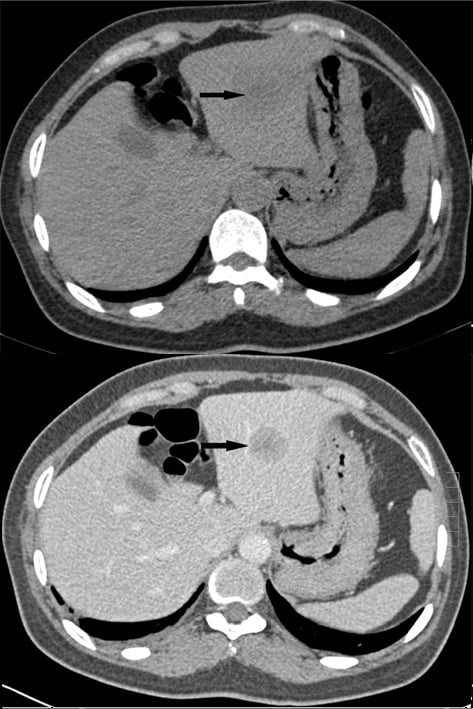Clinical Question: Role of Contrast in Abdominal CT for Adult Patients presenting with Acute Abdominal Pain
A 73-year-old male presents to your Emergency Department with vague LLQ abdominal pain. Your differential includes stones/pyelonephritis, diverticulitis, obstruction, and neoplasm. You want a CT scan to assist in diagnosis. A colleague mentions you need oral contrast to diagnose obstructions, and intravenous contrast to diagnose diverticulitis but intravenous contrast hinders the diagnoses of stones. What is the optimal scan?
CT Scans and the role of contrast
CT scanners pass X-rays to produce cross-sectional slices, which are reconstructed to generate images. Like plain-film X-rays, radiopaque structures (i.e., bone, calcium) appear bright on the images. Contrast agents are solutions containing radiopaque molecules and appear bright on imaging to highlight internal structures. This article will cover oral and intravenous contrast in abdominal CT imaging.
Looking at oral contrast
Oral contrast gathers and illuminates bowels, improving the ability to detect fistulae, interloop abscesses but reducing the ability to diagnose bowel wall pathology(enteritis/angioedema).1 Logistically, oral contrast administration takes hours and frequently does not traverse the entire gut, providing limited diagnostic utility.2 This can prolong length of stay.3 Plus, it can be unpalatable, resulting in vomiting.
Routine use of oral contrast has recently been questioned. While historically touted to facilitate diagnosing obstructions, perforations, and inflammatory conditions (i.e., appendicitis), these assertions are being challenged. The latest multidetector CT scanners have improved image quality, reducing the need for oral contrast to identify structures. Moreover, normal bowel secretions and air already serve as a contrast medium in small bowel obstructions, while contrast leakage from bowels has poor sensitivity (19-42%) for perforations.1,4 Recent studies show similar detection rates of appendicitis, diverticulitis, and small bowel obstructions irrespective of oral contrast.3,4 Moreover, centres that have omitted routine oral contrast for acute, atraumatic abdominal pain saw only 0.2% of their patients returning for repeat CT scans with contrast.5
What about intravenous contrast?
Intravenous contrast gathers in the blood, solid organs, kidneys, and urinary tract. It can delineate organs and the surface of the GI tract, helping show inflammation, perforations, neoplasms, and ischemia.6 For these reasons, the American College of Radiologists broadly recommends intravenous contrast for nearly all CT scans in abdominal pain using the “appropriateness criteria” (see Table 1).7 Regarding kidney stones, intravenous contrast is usually not appropriate when stones are primarily suspected, as non-contrast CT scans demonstrate 95% sensitivity for diagnosing kidney stones.8 However, in an undifferentiated patient, the use of intravenous contrast does not reduce sensitivity for detecting obstructing stones or stones > 3mm, which represent the majority of clinically relevant stones.9,10
Table 1. American College of Radiologists appropriateness criteria for recommended imaging studies, focusing primarily on IV contrast/non-contrast scans.7
| CT abdomen and pelvis with IV contrast | CT abdomen and pelvis without IV contrast | |
| Acute non localized abdominal pain. Not otherwise specified. | Usually Appropriate | May be appropriate |
| Suspected acute pancreatitis (atypical signs and symptoms)a | Usually Appropriate | May be appropriate |
| Epigastric pain with clinical suspicion for acid reflux or esophagitis or gastritis or peptic ulcer or duodenal ulcer. | May be appropriate | May be appropriate |
| Epigastric pain with clinical suspicion for gastric cancer. | Usually Appropriate | May be appropriate |
| LLQ pain, suspected diverticulitis | Usually Appropriate | May be appropriate |
| RUQ pain, suspected biliary disease. Negative or equivocal ultrasound. | Usually Appropriate | May be appropriate |
| RLQ pain, fever, leukocytosis. Suspected appendicitis. | Usually Appropriate | May be appropriate |
| Suspected small-bowel obstruction. Acute presentation. | Usually Appropriate | May be appropriate |
| Acute flank pain. Suspicion of stone disease. | Usually Inappropriate | Usually Appropriate |
| Acute pyelonephritis. Complicated patientb | Usually Appropriate | May be appropriate |
b: e.g,, Diabetes or immunocompromised or history of stones or prior renal surgery or not responding to therapy.
Bottom Line
For many historical indications, the efficacy of oral contrast has faded given advances in CT scanning technology. It seems reasonable to defer oral contrast for the initial study in an anatomically normal GI tract (no bowel surgeries or fistulizing disease). Intravenous contrast can be broadly applied with minimal drawbacks as the initial imaging study for most abdominal complaints.
Back to the Case
You readily obtain a CT scan administered with only intravenous contrast. His CT scan shows acute sigmoid diverticulitis with no frank perforations. As he is well-appearing, afebrile, and immunocompetent- he is discharged on oral antibiotics and told to follow up with his family doctor in 7 days.
This post was edited by Daniel Ting and copyedited by David Zheng.
References
- 1.Pickhardt PJ. Positive Oral Contrast Material for Abdominal CT: Current Clinical Indications and Areas of Controversy. American Journal of Roentgenology. Published online July 2020:69-78. doi:10.2214/ajr.19.21989
- 2.Laituri CA, Fraser JD, Aguayo P, et al. The Lack of Efficacy for Oral Contrast in the Diagnosis of Appendicitis by Computed Tomography. Journal of Surgical Research. Published online September 2011:100-103. doi:10.1016/j.jss.2011.02.017
- 3.Aycock R. News. Emergency Medicine News. Published online March 2018:29. doi:10.1097/01.eem.0000531144.44195.73
- 4.Atri M, McGregor C, McInnes M, et al. Multidetector helical CT in the evaluation of acute small bowel obstruction: Comparison of non-enhanced (no oral, rectal or IV contrast) and IV enhanced CT. European Journal of Radiology. Published online July 2009:135-140. doi:10.1016/j.ejrad.2008.04.011
- 5.Uyeda JW, Yu H, Ramalingam V, Devalapalli AP, Soto JA, Anderson SW. Evaluation of Acute Abdominal Pain in the Emergency Setting Using Computed Tomography Without Oral Contrast in Patients With Body Mass Index Greater Than 25. Journal of Computer Assisted Tomography. Published online 2015:681-686. doi:10.1097/rct.0000000000000277
- 6.Manual on Contrast Media. American College of Radiology. Published 2021. Accessed June 23, 2021. https://www.acr.org/Clinical-Resources/Contrast-Manual.
- 7.ACR Appropriateness Criteria. American College of Radiology. Published 2021. https://www.acr.org/Clinical-Resources/ACR-Appropriateness-Criteria
- 8.Brisbane W, Bailey MR, Sorensen MD. An overview of kidney stone imaging techniques. Nat Rev Urol. Published online August 31, 2016:654-662. doi:10.1038/nrurol.2016.154
- 9.Dym RJ, Duncan DR, Spektor M, Cohen HW, Scheinfeld MH. Renal stones on portal venous phase contrast-enhanced CT: does intravenous contrast interfere with detection? Abdom Imaging. Published online February 7, 2014:526-532. doi:10.1007/s00261-014-0082-4
- 10.Corwin MT, Lee JS, Fananapazir G, Wilson M, Lamba R. Detection of Renal Stones on Portal Venous Phase CT: Comparison of Thin Axial and Coronal Maximum-Intensity-Projection Images. American Journal of Roentgenology. Published online December 2016:1200-1204. doi:10.2214/ajr.16.16099
Reviewing with the Staff
This was a well written and well researched article. I feel reassured my practice is backed up by some research. Good discussion of IV contrast and oral contrast. Note that there are certain times where a non-contrast scan may be most appropriate which isn’t captured in your chart. (e.g., No IV access possible, predialysis patient). Obviously, there are limitations to such a scan. But a non-contrast scan is better than none. Also worth noting is the role of adipose in CT scans. At my centre, when looking for infectious/inflammatory changes (specifically scans to rule out appendicitis, pancreatitis, and diverticulitis), we forgo the oral contrast in obese (BMI≥35) patients because the adipose assists in making the diagnosis. While people order CT scans for duodenal/gastric pathology, it is not optimal at looking for duodenal/gastric pathology (which really requires gastroscopy), unless there\'s a transmural perforation.





